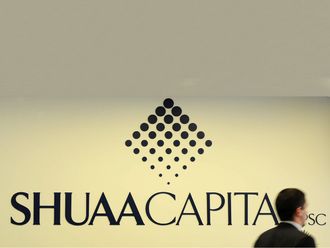Dubai: Last week, the Dubai Financial Market General Index (DFMGI) fell by 21.33 or 0.77 per cent to close at 2,736.40, the lowest weekly closing price since January 2016. Market breadth leant towards the bearish side, with only seven advancing issues versus 30 declining. Meanwhile, volume dropped to a four-week low.
As the DFMGI has been falling over the past four months or so, downward momentum has been slowing. For instance, the decline from the January swing high of 3,542.90 to the swing low in May was 19 per cent in 81 days. Contrast that to the decline off the subsequent lower swing high of 3,109.30 in June to last Thursday’s low (new trend low) of 2,706.90. During that time the index dropped 12.6 per cent in 91 days.
The pattern that is present is consolidation that is downward sloping, forming potentially bullish descending wedge trend reversal pattern. If we put a falling trend line across the top of the pattern and one across the bottom the two lines will eventually cross as they are angled towards each other. Such a configuration is labelled a potential bullish wedge as the breakout and therefore confirmation of the pattern has not yet occurred. This means that the pattern may evolve into a different pattern and never give a bullish breakout signal.
Nevertheless, wedge patterns can lead to explosive moves once a breakout triggers. This occurs initially on a move above the trend line and then strength is confirmed on a move above a prior swing high. It may be that the wedge in the DFMGI will continue to evolve as price moves lower before a breakout occurs, if it is to do so. The wedge pattern should be kept in mind if price starts to move above the trend line. The swing high that should be watched is 2,854.49, as a move above that price level will confirm strength and the bullish breakout of the wedge.
As a reminder, the January 2016 swing low of 2,590.72 is a significant support zone. Last week’s closing price is now only 5.2 per cent away from that low. Given that a daily close below that five-year low would be a significant bearish development, it seems possible that a rally could come before then. Just something to keep in mind as the DFMGI proceeds forward.
Abu Dhabi
The Abu Dhabi Securities Exchange General Index (ADI) declined by 106.48 or 2.13 per cent to end at 4,882.26, the largest one-week drop since June. There were nine advancing issues and 21 declining, while volume was cut almost in half from the previous week.
Regardless of last week’s larger than average decline, the index has so far stayed above support of the 10-week relatively tight consolidation pattern that has been forming around the top of the long-term uptrend and multi-year highs. This pattern has now evolved into a possible double top or rectangle pattern depending on which way breaks out, either up or down.
A decline below and subsequent daily close below support of the range at 4,859.21 will trigger a breakdown of the double top trend reversal pattern. This would signal that a deeper pullback from the recent 5,039.83 peak is coming. Consequently, price areas to watch for some degree of support include monthly support around 4,797.20. Then if price keeps falling, watch for support around a range from approximately 4,745 to 4,592. Those are all prior monthly resistance areas covering a greater than two-year time frame.
If on the other hand, an upside breakout occurs on a decisive move above 5,039.83, the recent consolidation pattern is considered to be a rectangle trend continuation pattern. The ADI would then be targeting the 2014 high around 5,149 to 5,255, with a strong possibility that it would eventually move above the high.
Stocks to watch
Following a 54.1 per cent correction to a low of 0.77 in early-July, Gulf Navigation has advanced as much as 51.9 per cent as of last week’s 1.17 high. The 18-month bear market that started off the January 2017 peak of 1.686 completed a 61.8 per cent Fibonacci retracement of the long-term uptrend (from 2015 lows) almost perfectly, as that retracement was at 0.767. This opened the path to the recovery that we’ve seen since.
A 61.8 per cent retracement is generally considered to be a full retracement of a prior trend within Fibonacci ratio analysis. This technique mathematically identifies potential support and resistance price levels ahead of time, where we might see a reversal.
Last week Gulf Navigation was the top performer in Dubai, up 0.10 or 9.9 per cent to close at 1.11. Weekly volume shot up to the highest level since December 2016, which was near the peak. The stock ended the week at a 10-month closing weekly high and establishes it as a leader in the Dubai market. For example, the correction in Gulf Navigation is showing completion of the bear market and the start of a bull run, while the DFMGI has yet to stop going down, never mind reversing the bear trend.
Currently, the Gulf Navigation is extended but it can be watched during weakness for potential entry opportunities that take into account a plan for risk management.
Bruce Powers, CMT, is a technical analyst and global market strategist.











